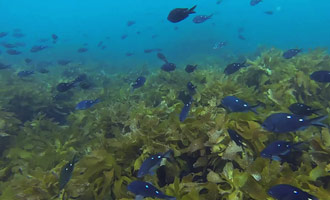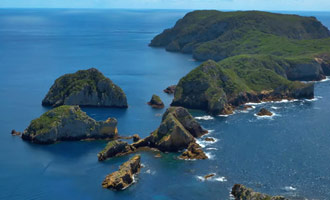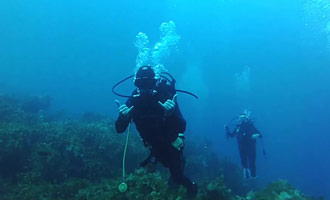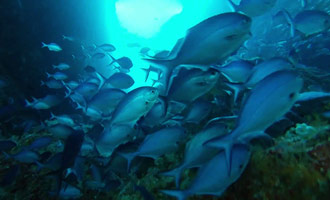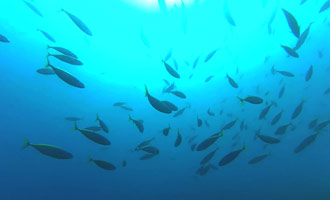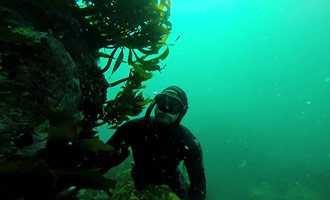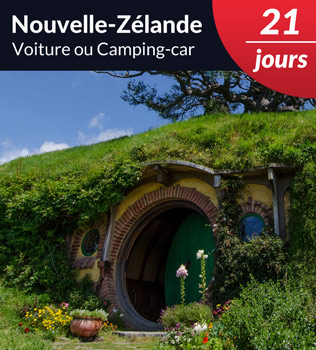
Your First Dive in New Zealand.
Please contact us and we will help you to organize your trip! It's free and without commitment.
- Read the post
- Details
- Advices
The Practical Guide of the Activity.
- 1Beautiful Underwater Landscapes.
- 2Diving at the Poor Knights Islands.
- 3How to Organize a Dive at the Poor Knight Islands?
- 4Program of a Dive With Dive Tutukaka.
- 5Safety Instructions to Be Observed Underwater.
- 6The Three Best Diving Spots in the Country.
- 7The Five Best Wreck Dives in the Country.
- 8Should You Book a Dive in New Zealand?
Beautiful Underwater Landscapes.

Diving in New Zealand is exceptional.
Diving in New Zealand takes place in a subtropical environment. A term that often misleads divers who dream of multicolored coral and clownfish.
Scuba diving in New Zealand is a nice surprise for travelers who wish to explore spectacular seabed.
Off the North Island, the Poor Knight Islands are among the best-dive sites according to the famous Commandant Cousteau.
The aquatic landscape is finally very different to what one could expect, with an incredible underwater life, and a volcanic activity (the country is located on the Pacific belt of fire) which is at the origin of striking reliefs.
Diving fans will be happy to explore the Rainbow Warrior of Greenpeace and other wrecks transformed into artificial reefs. However, this kind of dive may require a minimum of experience.

You can even dive to explore wrecks.
The beginner divers are obviously welcome: dive baptisms are very popular wedding gifts in New Zealand.
For their part, experienced divers will be able to simply rent their equipment and conduct several sessions during the same day.
Fortunately, if scuba diving is not a cheap activity, it leaves memories unforgettable.
The initiation and rental of equipment will cost the double (if not the triple) of what a kayak guided tour would cost, but the intensity of the experience is incomparable.
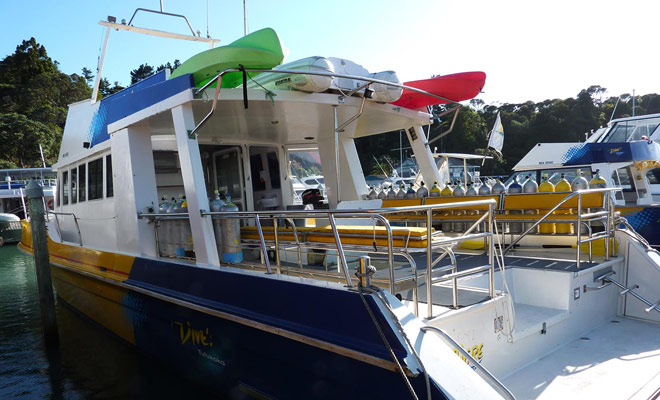
Dive Tutukaka is the best diving company in the country.
An essential part of the article is devoted to present the activities from a dive company named “ Dive Tutukaka ”.
A decision made in full independence by Kiwipal, and justified by the unfailing professionalism of this organizer and by the quality of the dive sites covered.
We are obviously not going to try to list every dive spots, and we will only focus on the best spots accessible to everyone.
As usual on Kiwipal, the practical aspect will be highlighted: you will know everything you need to know to book a baptism of diving, and I will also review the best dive spots, including the ones on the most impressive wrecks of the country.
Diving at the Poor Knights Islands.
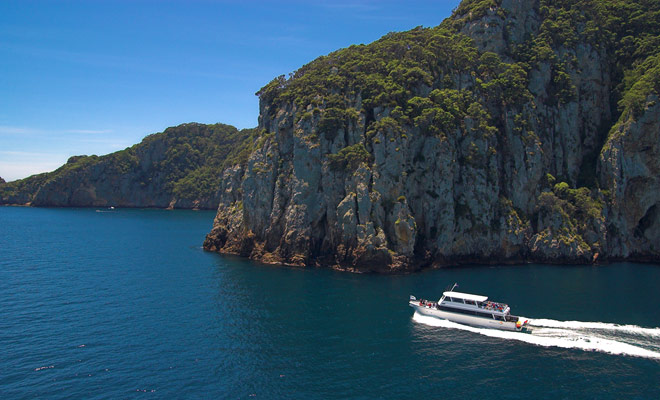
The Poor Knight Islands are off the North Island.
Nature reserve located 12 nautical miles from the east coast of the North Island (2h30 drive from Auckland or 1 h 15 from Paihia to get to the coast), the Poor Knight Islands have been uninhabited volcanic islands for two Centuries.
The two main islands of the archipelago, Tawhiti Rahi and Aorangi are regularly cited among the best-dive sites in the world.
Commandant Cousteau ranked the Poor Knight Islands at the 7th position in his Top 10 favorite dive sites.
Hot currents favor aquatic life and the beauty of underwater landscapes impress even experienced divers. A tormented relief made up of caves and stone arches shelters thousands of blue maos-maos whirling around divers, while grouper, moray eels and scorpion fish explore the nudibranchs.

Underwater caves hide under the surface.
A fabulous show with diving areas adapted to all levels. Depths range from 10 to 40 meters (33 to 130 feet) with excellent visibility up to 30 meters in clear weather.
How to Organize a Dive at the Poor Knight Islands?
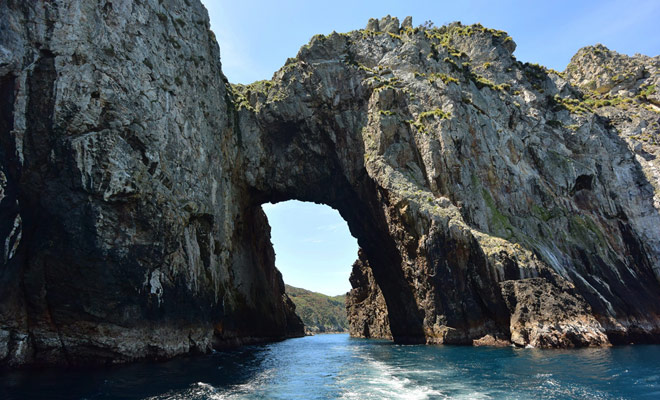
The boat is the only way to reach the Poor Knight islands.
We will review the organization of a scuba diving initiation at the Poor Knight Islands with Dive Tutukaka. The rates are here for information only, and I recommend you to consult the official website of the company to make your reservations.
Where to Stay in the Region?
The Poor Knight Islands is an uninhabited nature reserve without any possibility of accommodation on site.
Located at only 25 km from Tutukaka, the nice city of Whangarei is the best choice for accommodation.
When to Dive at the Poor Knight Islands?
It is possible to dive theoretically throughout the year, but the ideal conditions are from late January to early April (mid summer to mid autumn) when the water temperature reaches 20 to 23 ° C with maximum visibility of 25 m. Outside of this interval, prefer the months of May to September, because the calmer waters favor an optimal visibility up to 30 m.
Avoid the period between October and December, because if plankton attracts more fish, reducing visibility to less than 15 m.
Which Dive Company to Choose?
Dive! Tutukaka has the monopoly of diving on this site. The company has won many many New Zealand Tourism Awards, and is rightly considered to be the best dive company in the whole country. Founded in 1999, it now also offers kayak outings and snorkeling as well.
What Budget to Plan for a Dive?
Only experienced divers can rent their own equipment for an unaccompanied session.
For the majority of the travelers it will be mainly question of baptism or of guided diving.
Dive Tutukaka has three offers, tailored to the level of the participants whether novice, beginners or expert. The dive sites are sufficiently varied so that everyone can find its happiness there.
Diving Initiation
The service charged $200 per person includes equipment rental and supervision with experienced diving instructors.
Beginner Diver
If you have already dived in the past but do not practice often, this excursion with a guide allows up to two dives during the same trip! The tariff then climbs to $299, which is reasonable in New Zealand.
Experienced Diver
The spots are quite similar to the ones offered to beginners, but you will dive twice without a guide and for a very competitive rate of $269. You will also have the possibility to dive on the wrecks of the Tui or the Waikato (see the section below devoted to the wrecks) for $255.
How Long Does a Dive Last?
Each dive lasts on average between 25 and 35 minutes, but it all depends on your underwater activity and you may sometimes reach 40 minutes. But don't worry, I will present the activity in detail during the following part of the guide.
Program of a Dive With Dive Tutukaka.
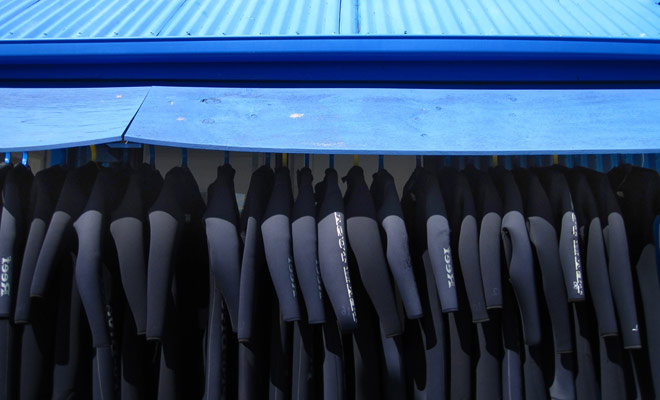
Dive Tutukaka provides all the necessary equipment.
You will have to present yourself at the reception of Dive Tutukaka at 8 AM precisely to fulfill the formalities of use (papers to be signed, equipment to collect, etc.). The reception point that resembles an underwater cave is impossible to miss. Do not forget to bring some sandwiches!
Boarding begins at 8:30 am and the presentation of the Dive Tutukaka Team is followed by the traditional briefing on safety.
The boat heads directly towards the Poor Knight Islands (or towards the wrecks, depending on the chosen option). Sailing to the archipelago takes about an hour and you can spot dolphins and sometimes whales! on the way.
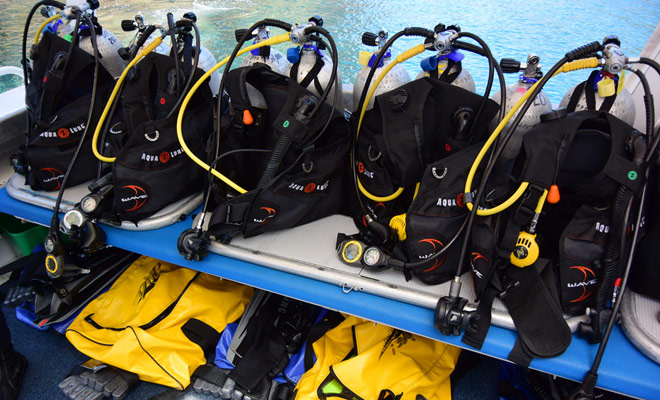
You will be trained to learn how to use the equipment.
The captain takes the time to find a diving spot adapted to the weather of the day and the strength of the current. You can begin to put a combination whose thickness varies depending on the season (usually 7 mm in summer) and a buoyancy compensator.
During initiations or outings between beginners, each dive group is limited to a maximum of six participants plus the instructor.
With a 12-liter bottle on your back, you can expect to remain underwater practically 40 minutes at a depth of 20 meters, but the dive is usually shortened by the monitor who prevents you exhausting your oxygen reserve.

It's time to get ready to dive with the instructor.
If the booking allows two dives, you can enjoy a well deserved break.
Drinks (coffee, chocolate, hot soups ...) are included in the price, and a good hot shower awaits you in a cabin. According to the weather, you may test the effectiveness of your sunscreen on the deck while admiring the islands.
You are free to lunch whenever you want, but you should avoid eating just before your second dive of the day in the early afternoon.
Since the interval between the dives is about 1 h 30, do not wait too long to eat if you want to dive again.
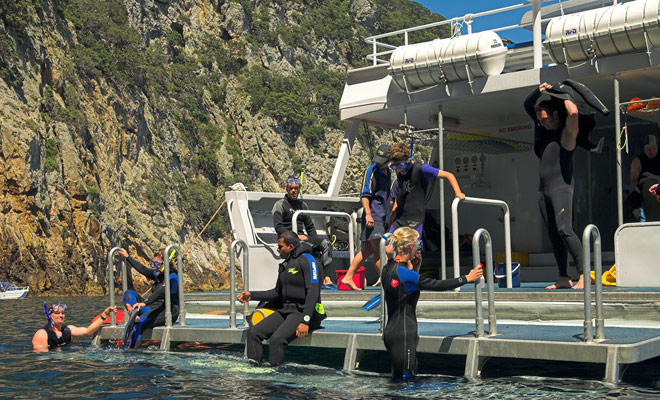
You can relax on the bridge between two dives.
You'll leave the Poor Knight Islands at 2 pm and you will be back at Tutukaka between 3:30 pm and 4:30 pm depending on your booking.
A convenient schedule which allows you to return to Paihia in the Bay of Islands or to Auckland in the early evening.
Safety Instructions to Be Observed Underwater.

Follow the instructions of the dive instructor to the letter.
Accidents that occur during guided diving are extremely rare. The equipment can't be booked all alone if you have never dived before, but anyway no beginner would take the risk to dive without training or supervision.
A diving monitor must have hundreds if not thousands of dives to their credit. Baptisms of diving leave no room for chance, and a meticulous care is given to the questions of security.
Diving is a sport whose contraindications are not taken lightly.
A medical check-up is required prior to your departure in New Zealand, because some medications are incompatible with diving (including sedatives, sleeping pills and analgesics for example) and only your doctor can tell you if you are able to dive or not.

The magnificent spectacle should not make us forget the risks.
Diving is, of course, prohibited to any pregnant woman, or to people suffering from respiratory or cardiac problems.
Because underwater pressure is not the friend of dental fillings (which can blow up), you should also plan a check-up visit at your dentist.
Finally, common sense recommends not to dive in a state of fatigue or lack of sleep.
Especially avoid planning this activity at the beginning of your stay in New Zealand to have time to recover of the jet lag.
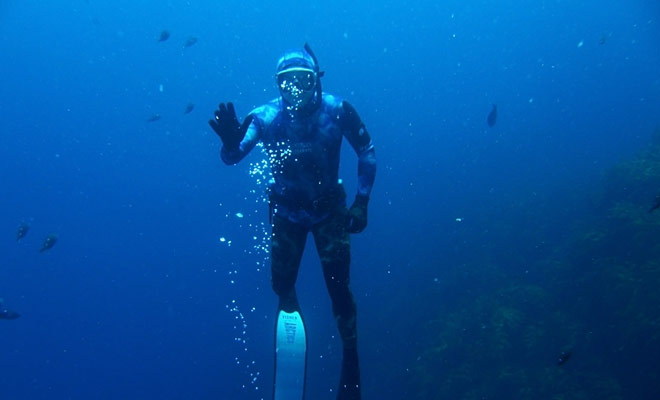
Report any problems to your dive monitor.
Paying for an insurance may seem optional for a few weeks of vacation, but it is absolutely essential to be covered if you plan to dive.
Take a serious insurance policy (e.g. Chapka) and make sure that emergency repatriation and incidents related to scuba diving are well covered.
Itching, joint pain or vertigo (among others) are strong signals that impose the return to the surface.
In such rare situation, you only have to follow the procedure and the instructions given by your monitor and everything will be fine.

Scuba diving does not present any particular risks.
Don't be afraid, the instructors are also rescuers trained to handle any crisis. I hope not to have alarmed you (99% of the dives occur without incidents), but if I succeeded in making you aware of the importance of the security during a dive, that's already great!
The Three Best Diving Spots in the Country.

Some exceptional sites are unfortunately difficult to access.
It is often said that the Three King Islands spot is the most beautiful diving site of New Zealand. The archipelago is unfortunately 34 nautical miles (55 km) off Cape Reinga, and no dive company covers such a distant spot.
The development of tourism in New Zealand will certainly provide a solution to visit the Three Kings Islands sooner or later, but in the meantime, here are the best diving spots you can consider during your holidays.
Poor Knight Islands
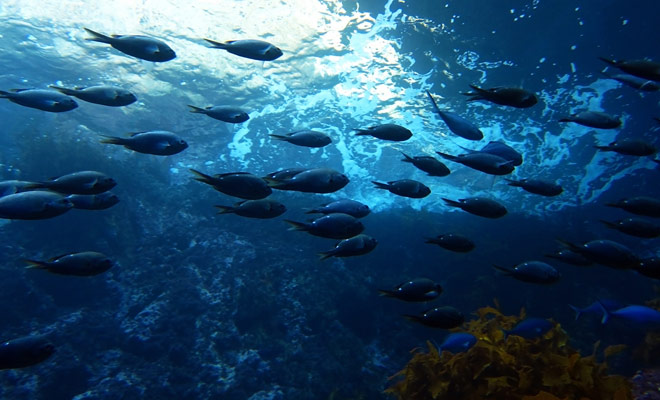
The dive site of the Poor Knight Islands is a must.
The archipelago (presented in detail on this very same page) was ranked in 7th position in the top 10 of Commander Cousteau. The world's largest underwater cave is an unmissable attraction to which one must add the thousands of fish and volcanic formations of all beauty. The wrecks nearby (the Tui and the Waikato) are fantastic and also bookable with “Dive! Tutukaka”.
Milford Sound
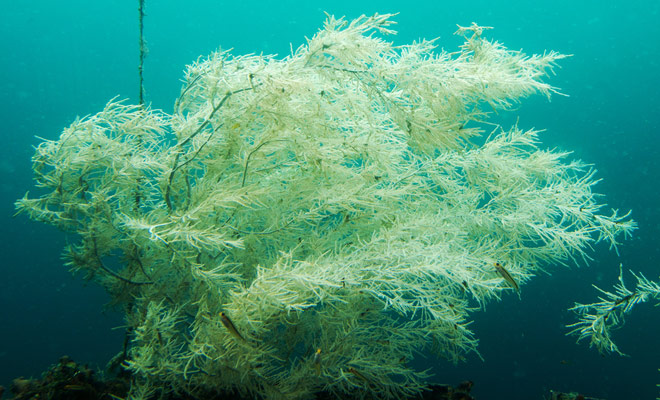
Milford Sound is a unique dive site in the world.
The finest fiord of the country allows novice divers to admire a spectacle usually reserved for experienced divers.
The deposition of fresh water due to the region's exceptional rainfall reduces the brightness and allows the black coral to grow at a depth of seven meters instead of forty! A rich aquatic life and some curious dolphins complete an extraordinary underwater landscape. An experience to live in Milford Sound with the Descend company.
White Island
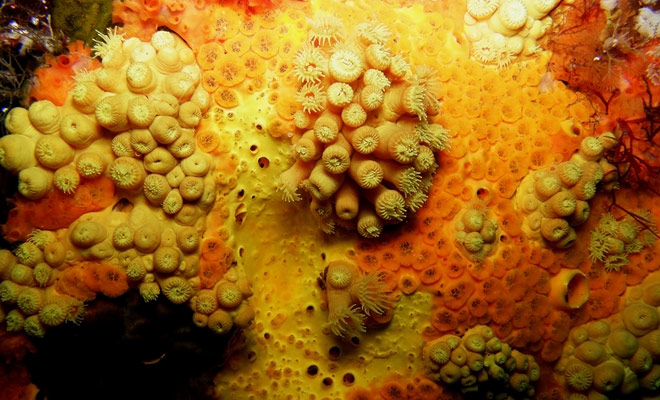
The underwater life is impressive near the volcanoes.
White Island, the country's most active volcano is 32 nautical miles (50 km) off the Bay of plenty.
A deep underwater canyon fed by a subtropical current allows the existence of a rich aquatic life. With visibility up to 40 meters, you will often have the opportunity to observe many species of sharks chasing smaller fish.
As for the lobsters that hide in the black coral, they may be on the menu for your next meal! The company “Dive White” organizes the dives at White Island.
The Five Best Wreck Dives in the Country.
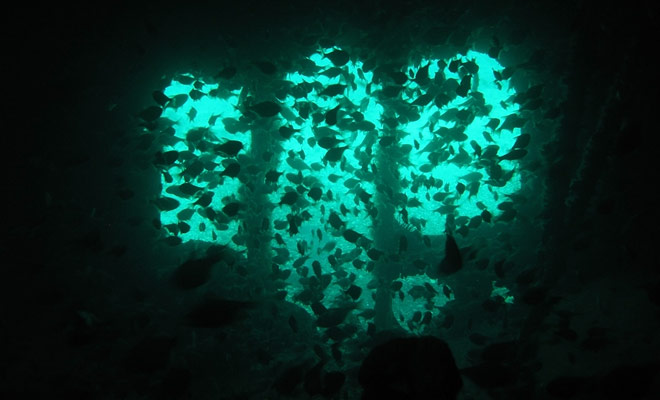
Exploring wrecks is a dream for many divers.
Wreck diving has always captivated the public, and the spectacle of an old ship eaten by coral recalls the treasure hunt stories of our childhood. But diving in the corridors of a wreck is not intended for beginners.
It takes a minimum of experience to explore a wreck, but nothing prevents you from observing them without going inside.
The diving companies are able to adapt their program to the level of the participants and your dream could become reality.
Here is the list of the five best wreck diving spots in New Zealand.
You have plenty of choice, with a military frigate, a cruise ship and even the famous Rainbow Warrior, which undermined relations between France and New Zealand in the 1980s.
Diving the Tui

Some wrecks now serve as natural reefs.
Scuttled voluntarily in 1999 off Tutukaka, this former warship has become an artificial reef. It takes 10 minutes by boat to reach the dive site where the wreck lies at 115 feet (35 meters deep). The benches of golden snappers swim in every corridor. TheDive! Tutukaka company will organize your exploration with a guide.
Diving the Waikato

However, diving on a wreck requires caution.
This frigate, also scuttled near Tutukaka, is the delight of divers who come to admire its cannons and the intact turrets. More accessible than the Tui, the wreck rests at 29 meters, making it the ideal site for diving baptisms. Large holes were cut in the hull to facilitate the entry and exit of the divers. Here again, you can trust Dive! Tutukaka to organize an outing.
Diving the Canterbury
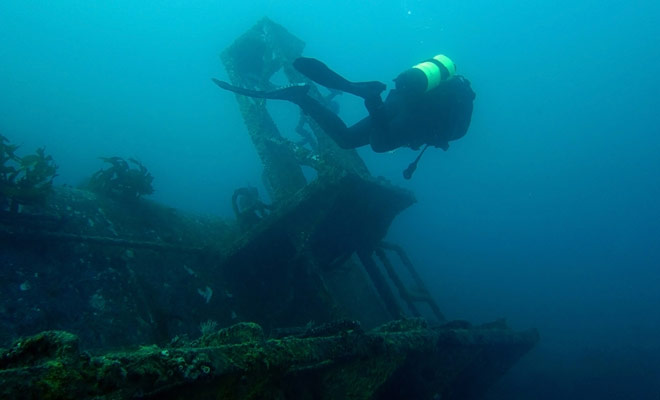
The Canterbury was voluntarily sunk to serve as a reef.
Frigate disarmed and voluntarily scuttled to become a reef, the Canterbury lies in the bay of the islands (Bay of Islands) at a depth between 14 and 40 meters. A magical show awaits you in the former command post where hundreds of fish swim. Paihia Dive ensures the guided tour and plan the activity according to your level (attention: the lower bridges require a good level of diving).
Diving the Mikhail Lermontov New Zealand EEL

The Mikhail Lermontov was an immense cruise ship.
The Mikhail Lermontov is the only wreck in this classification off the South Island and the largest shipwreck in Oceania (its tragedy dates back to 1986).
The reasons for the sinking of this imposing cruise ship remain unclear, and spying rumors still circulate today.
The wreck rests in the Marlborough Sound and the upper deck which is only 14 meters below the surface is easily accessible to beginners thanks to the Go Dive company. The exploration the bridges at 36 m deep is, however, only available for experienced divers.
Diving the Rainbow Warrior
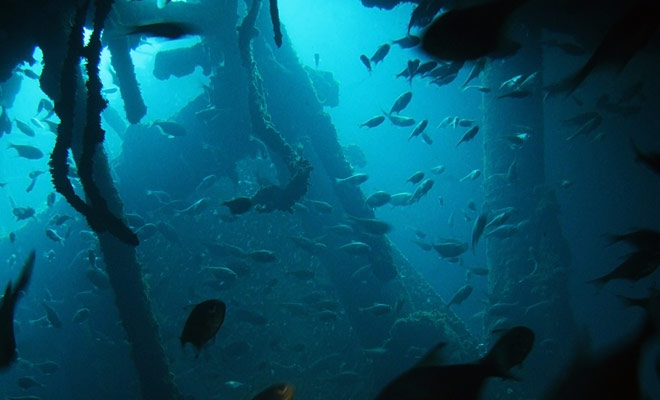
The Rainbow Warrior was sunk by France in 1984.
The most famous wreck of New Zealand is certainly not the most beautiful of our rating, but its history is important.
Originally sunk by the French intelligence services as part of the scandalous affair of the same name, the Rainbow Warrior was bailed out for the purpose of the investigation before being voluntarily scuttled a second time in the Bay of Islands. The 45 m ship lies at a shallow depth (between 18 and 26 meters) and shelters splendid anemones. Paihia Dive will lead you to its discovery.
Should You Book a Dive in New Zealand?

I recommend the diving baptism in New Zealand.
If you are planning a diving baptism in New Zealand, I recommend you to book it during the summer because the water quite cold enough the rest of the year and a thick combination will therefore be required.
The main criticism about diving is that it is an expensive activity.
Even if everything is relative, because a parachute jump lasts on average five minutes for the price of one hour of diving!
The diving companies are not rare in New Zealand, but I advise you to choose Dive Tutukaka to explore the Poor Knight Islands. The organization is perfect and only a very bad weather would hurt the experience.
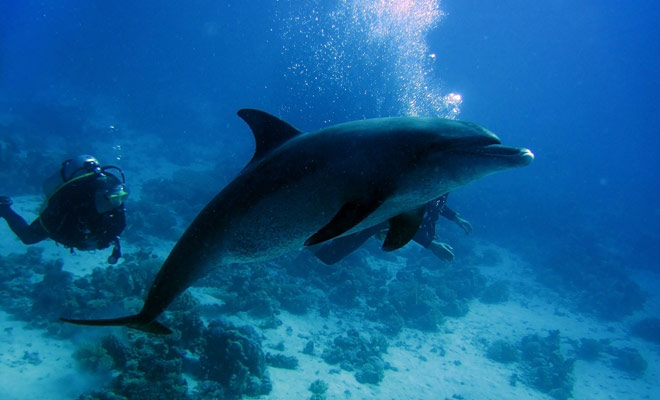
Sometimes the dolphins mingle with the divers.
When there are no dolphins to catch your attention, sea sickness can take you by surprise if the swell rises during the trip. If you need medication, make sure that your products are compatible with a dive session by consulting your doctor prior to your departure to New Zealand.
Most experienced divers know how boring it can be to go diving with a group of beginners. I recommend to them to opt instead for a dive on a wreck if they don't want to wait for an eternity before everyone is equipped.
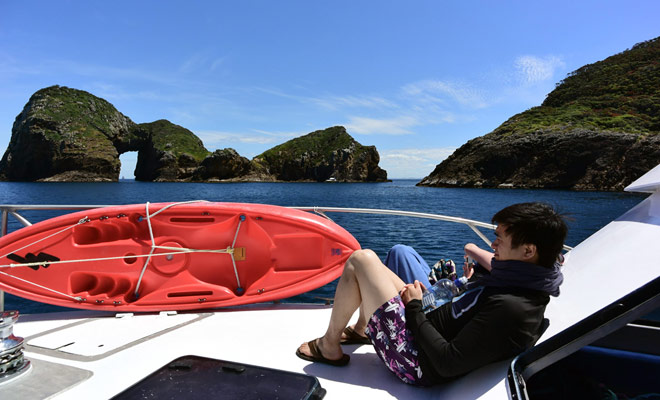
This may become your new passion.
Do I still need to introduce Ben, Kiwipal's best Guide? Passionate by scuba diving since his 20s, Ben animates his own rubric of practical advice. If you have any technical questions about diving, feel free to contact him!


Questions & Answers.

What can I do for you? I am a devotee of wreck diving and I can help you prepare your diving baptism in New Zealand.
- All topics ... 4 answers in total
- Poor Knight Islands Diving 2 answers
- Diving 2 answers
Poor Knight Islands Diving
- What company to dive at the Poor Knight Islands?
There is only one company, Dive Tutukaka, but the services offered are impeccable.
- How to get to Tutukaka?
Buses run between Whangarei and Tutukaka in only 25 minutes. Check the schedules on the websites of the major bus companies, or contact Dive Tutukaka to book a shuttle for $20 (twice a day).Dive TutukakaKiwi ExperienceIntercityStray BusesNaked bus
Diving
- Can we wear glasses for diving?
Diving companies generally provide a suitable mask that improves vision, but be careful to ask the question by email or phone before booking your dive.
- Can we film under water?
The Go Pro cameras with waterproof cases are affordable, but you will also need a leach to attach the camera to your wrist, and a headlight to improve the image quality. The red filter is also indispensable to obtain a satisfactory color rendition! All this is not ideal for a diving baptism, and the making of films should be reserved to regular divers.

